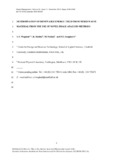JavaScript is disabled for your browser. Some features of this site may not work without it.
| dc.contributor.author | Wagland, Stuart Thomas | |
| dc.contributor.author | Dudley, R. | |
| dc.contributor.author | Naftaly, M. | |
| dc.contributor.author | Longhurst, Philip J. | |
| dc.date.accessioned | 2016-08-26T13:49:18Z | |
| dc.date.available | 2016-08-26T13:49:18Z | |
| dc.date.issued | 2013-07-20 | |
| dc.identifier.citation | S.T. Wagland, R. Dudley, M. Naftaly, P.J. Longhurst, Determination of renewable energy yield from mixed waste material from the use of novel image analysis methods, Waste Management, Volume 33, Issue 11, November 2013, Pages 2449-2456 | en_UK |
| dc.identifier.issn | 0956-053X | |
| dc.identifier.uri | http://dx.doi.org/10.1016/j.wasman.2013.06.021 | |
| dc.identifier.uri | http://dspace.lib.cranfield.ac.uk/handle/1826/10458 | |
| dc.description.abstract | Two novel techniques are presented in this study which together aim to provide a system able to determine the renewable energy potential of mixed waste materials. An image analysis tool was applied to two waste samples prepared using known quantities of source-segregated recyclable materials. The technique was used to determine the composition of the wastes, where through the use of waste component properties the biogenic content of the samples was calculated. The percentage renewable energy determined by image analysis for each sample was accurate to within 5% of the actual values calculated. Microwave-based multiple-point imaging (AutoHarvest) was used to demonstrate the ability of such a technique to determine the moisture content of mixed samples. This proof-of-concept experiment was shown to produce moisture measurement accurate to within 10%. Overall, the image analysis tool was able to determine the renewable energy potential of the mixed samples, and the AutoHarvest should enable the net calorific value calculations through the provision of moisture content measurements. The proposed system is suitable for combustion facilities, and enables the operator to understand the renewable energy potential of the waste prior to combustion. | en_UK |
| dc.language.iso | en | en_UK |
| dc.publisher | Elsevier | en_UK |
| dc.rights | Attribution-Non-Commercial-No Derivatives 3.0 Unported (CC BY-NC-ND 3.0). You are free to: Share — copy and redistribute the material in any medium or format. The licensor cannot revoke these freedoms as long as you follow the license terms. Under the following terms: Attribution — You must give appropriate credit, provide a link to the license, and indicate if changes were made. You may do so in any reasonable manner, but not in any way that suggests the licensor endorses you or your use. Information: Non-Commercial — You may not use the material for commercial purposes. No Derivatives — If you remix, transform, or build upon the material, you may not distribute the modified material. No additional restrictions — You may not apply legal terms or technological measures that legally restrict others from doing anything the license permits. | en_UK |
| dc.subject | Biogenic content | en_UK |
| dc.subject | Renewable energy | en_UK |
| dc.subject | Mixed wastes | en_UK |
| dc.subject | Image analysis | en_UK |
| dc.subject | Energy from waste | en_UK |
| dc.title | Determination of renewable energy yield from mixed waste material from the use of novel image analysis methods | en_UK |
| dc.type | Article | en_UK |
Files in this item
This item appears in the following Collection(s)
-
Staff publications (SWEE) [2827]
